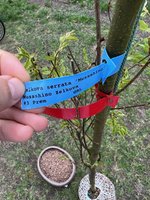To clarify I am in Boston MA and I have kept it inside for winter, treating it as house plant. I am planning to take it outside any day now.m
In general I wouldn't put a tree in that size pot until you got it cut down.
What type and size of tree are you trying to make? The cut you indicate would leave a fairly straight untappered section (most of which would be below the graft).
If it were mine I would put it in a larger nursery container or in the ground take an air layer off the top later in the season to start a small broom style. That will trigger more buds to pop below the layer and perhaps you can take another layer next year.
In you go with a nursery pot you will need to stake it down.
Have you been out to Bonsai West or New England Bonsai Gardens?
Again that article by Brent Watson is helpful for this as well. I am trying to make relatively small tree say 12-15" total in the end. Trunk at the base is almost 2 " diameter right now. I have almost zero experience with deciduous trees, so if you think I should not waist time on this tree let me know.
Otherwise:
I will do air layering suggestion taken on the top, however it will result in rather small trunk. When taken air layer from top I assume you would put it in ground and let it grow further to develop thicker trunk?
Am I missing something about trunk at bottom? Does the fact that this is grafted tree make it non-usable for Bonsai? What tells you this is grafted tree? Sorry, all of this I am asking to see if it makes sense to do the following:
-Plant tree in nursery pot or ground and wait until next Spring
-At that point trunk should be in 2-2.5" diameter range. I will cut it about 4" from the bottom and let it grow further trying to follow direction from Brent Watson's article.
Thanks again. Yes I have been to both Bonsai West and New England Bonsai Gardens. I am attending a class at Bonsai West next Friday.



